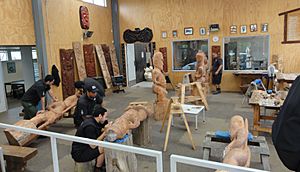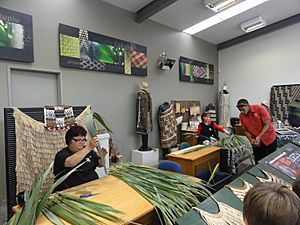New Zealand Māori Arts and Crafts Institute facts for kids

Logo
|
|
| Other name | Te Puia |
|---|---|
| Motto | Ngā Kete Tuku Iho |
| Motto in English | The heirloom baskets (of knowledge) |
| Founder(s) | Tā Āpirana Ngata (legislator) Hōne Taiapa (carver) Emily Schuster (weaver) |
| Established | 1926, reestablished 1963 |
| Focus | Revival and perpetuation of traditional Māori Arts |
| Formerly called | Rotorua Māori Arts and Crafts Institute |
| Location | , , |
| Address | Hemo Rd, Tihiotonga 3010 |
The New Zealand Māori Arts and Crafts Institute (NZMACI) is a special school in Rotorua, New Zealand. It teaches traditional Māori art forms. This institute helps keep Māori culture and skills alive.
NZMACI first opened in 1963. It continued the work of an earlier national school for woodcarving that started in 1926. That first school was set up by Sir Āpirana Ngata. He wanted to make sure traditional Māori arts did not disappear. The school is located in Whakarewarewa, a place known for Māori arts. Being near Rotorua's tourist areas helps the Institute earn money. This means it can run on its own. The school is part of Te Puia, a popular tourist attraction.
Contents
History of the Institute
The New Zealand School of Māori Arts and Crafts was founded in 1926. It was started by Āpirana Ngata, a Member of Parliament. He believed that art was very important for keeping Māori culture strong. The school taught traditional Māori arts and crafts. It was located near the geysers in Whakarewarewa, outside Rotorua. This first school closed during World War II.
In 1963, a new law created the Rotorua Maori Arts and Crafts Institute. Another law in 1967 changed it to a national institute. This meant it served all of New Zealand, not just Rotorua. Over time, the spelling of "Maori" changed to "Māori". This was done to match the correct Māori language pronunciation.
Since the 1980s and 1990s, Māori traditions have influenced modern art in New Zealand. NZMACI still focuses on teaching traditional art. You can visit the Institute through Te Puia. It is a major tourist spot in Rotorua, Aotearoa.
The Art Schools
Wood Carving Skills
Whakairo is the Māori word for carving. It is a very important art form for Māori people. Some even call it the written language of the Māori.
The National Wood Carving school is called Te Wānanga Whakairo Rākau o Aotearoa. It opened in 1967. Since then, it has helped restore or build over 40 whare whakairo (carved meeting houses) across New Zealand. The first head of the Carving school was Hone Taiapa, a famous master carver.
Jade, Bone & Stone Carving
This art form was once part of the main carving school. Now, it has its own special school called Te Takapū o Rotowhio. It was named by local leaders. This school first focused on carving pounamu (greenstone).
Today, Stacy Gordine leads this school. He is a master carver from the Ngāti Porou tribe.
Traditional Weaving
Traditional Māori textiles and weaving are taught at the Institute. This art is often called raranga in the Māori language.
The weaving school, Te Whare Raranga, started in 1967. Emily Schuster was its first head. In 1988, it was renamed Te Rito. Emily Schuster led the school until the mid-1990s. She continued as a cultural advisor until she passed away in 1997.
Her daughters, Dawn Smith and Edna Pahewa, followed her as leaders. Edna Pahewa held the role for 18 years. The current head is Meleta Bennett, a master weaver. She was taught by Edna Pahewa.
The founding of these schools helped bring back Māori carving and weaving. Many students from these schools played a big part in the Māori renaissance.
Major Artworks and Projects
Marae Restoration and Building
NZMACI has helped build or restore over 40 marae (Māori meeting grounds). Many more have been worked on by graduates of the Institute. Early students worked on art for local businesses. Later, they helped restore carvings on Māori churches and meeting houses.
Te Matatini Stage
The Institute carved the Māhau stage for Te Matatini. This is the world's largest Māori cultural festival. The stage is huge, measuring 30 meters wide and over 13 meters high. It is made from 26 tonnes of native wood, 5 tonnes of steel, and 36 tonnes of concrete. This makes it the largest Māori carved structure ever. More than 20 staff and students worked over 15,000 hours on it. The carvings tell stories about performing arts in Aotearoa. Te Māhau was first used in 2012.
Pou Maumahara
The Pou Maumahara is a special carving in Zonnebeke, Belgium. It remembers soldiers who died in war. This 8-meter tall, 17-tonne woodcarving was made from a kauri log at NZMACI. Clive Fugill designed it. Staff and students carved it under the lead of James Rickard. The project took over four years. The pou was unveiled on ANZAC Day in 2019.
Te Ahi Tūpua Sculpture
Te Ahi Tūpua is a large sculpture designed by Stacy Gordine. It uses traditional Māori art to tell the story of Ngātoro-i-rangi. He was an ancestor who guided the Te Arawa canoe to Aotearoa. He is linked to the geothermal activity in the Rotorua area.
Te Ahi Tūpua is 12 meters high. It is the tallest sculpture of its kind. It is also the first of its kind made using 3D printed parts.
This sculpture was part of a big project to improve the Hemo Gorge roundabout. The project was funded by the New Zealand Transport Agency and the Rotorua District Council. Te Ahi Tūpua, along with Pōhutu Geyser and the local lakes, is now a symbol for the city of Rotorua.
Artists and Students
Students at NZMACI are called Reanga. They are chosen from many applicants to learn Māori Arts and Crafts. They often receive a scholarship. Students are usually Māori people who already practice traditional arts. They are expected to use their skills to help their tribes and communities.
Graduates of the Institute
Here are some notable graduates:
- Pine Taiapa (1926 institute)
- Hōne Te Kāuru Taiapa (1926 institute), the first master carver of the revived school.
- Piri Poutapu (1926 institute, 1929 intake), a carver of canoes and royal carver.
- Clive Fugill (Wānanga Whakairo Rākau, 1st intake)
- James Rickard (Wānanga Whakairo Rākau, 1st intake), a master carver.
- Dr Lyonel Grant (Wānanga Whakairo Rākau, 6th intake)
- Riki Manuel (Wānanga Whakairo Rākau, 8th intake)
- Albert Te Pou (Wānanga Whakairo Rākau, 8th intake), current head of the carving school.
- Mauri Ora Kingi (Wānanga Whakairo Rākau, 8th intake)
- Fayne Robinson (Wānanga Whakairo Rākau, 13th intake), a well-known artist from the South Island.
- Roi Toia (Wānanga Whakairo Rākau, 14th intake)
- Gordon Toi (Wānanga Whakairo Rākau), a famous tohunga tā moko (Māori tattoo) artist.
- Arekatera Katz Maihi (Wānanga Whakairo Rākau, 21st intake), also a musician and tā moko artist.
- Colin Tihi (Wānanga Whakairo Rākau, 19th intake; Takapū 6th intake), a carver and painter. He is the only person to graduate from both carving schools.
School Leaders (Tumu)
Each school has a leader called a Tumu. These are experts in their art form. They teach the students along with other tutors.
Leaders of Te Wānanga Whakairo o Aotearoa (Carving School)
- (1967 - 1979) Hone Taiapa
- (1983 - 1995) Clive Fugill
- (2019 - 2023) Albert Te Pou
- (2023 - present) Grant Marunui
Leaders of Te Takapū o Rotowhio (Jade, Bone & Stone Carving School)
- (2009 - 2013) Lewis Tamihana Gardiner
- (2013 - present) Stacy Gordine
Leaders of Te Rito o Rotowhio (Weaving School)
- (1969 - 1997) Emily Schuster
- (1997 -2019) Edna Pahewa
- (2020-present) Meleta Bennett
How the Institute is Managed
In the past, the Minister for Tourism appointed people to the NZMACI board. Board members have included: Robert McFarlane, Ani Waaka, David Thomas, Sir Howard Morrison, Dr Erihapeti Rehu-Murchie, June Grant, Judith Stanway, Ray Watson, Erenora Puketapu-Hetet, Mike Simm, David Tapsell Ken Raureti, Robyn Bargh and Tupara Morrison.
Changes have been made to how the Institute is governed. This is due to agreements between the New Zealand government and local Māori tribes. As of 2020, the local tribes: Tuhourangi, Ngāti Wāhiao and Ngāti Whakaue are recognized as the traditional owners of Te Puia. They now have official representation on the board.
See also
- Pounamu
- Whakairo
- Māori traditional textiles
- Tāniko





